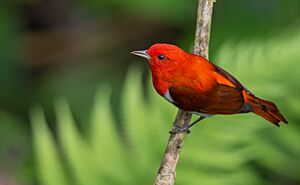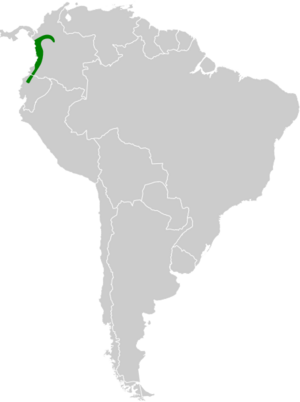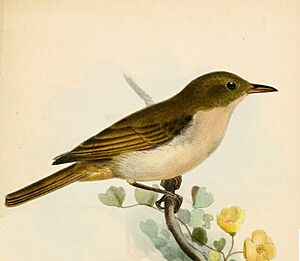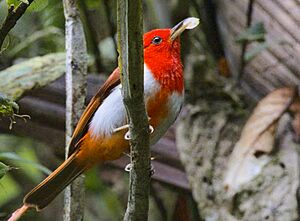Scarlet-and-white tanager facts for kids
Quick facts for kids Scarlet-and-white tanager |
|
|---|---|
 |
|
| Male | |
| Conservation status | |
| Scientific classification | |
| Genus: |
Chrysothlypis
|
| Species: |
salmoni
|
 |
|
The scarlet-and-white tanager is a beautiful bird from the Thraupidae family. Its scientific name is Chrysothlypis salmoni. You can find it in Colombia and northern Ecuador. It lives in warm, wet forests, even in areas where forests have been changed by people.
Male scarlet-and-white tanagers are very easy to spot! They have bright red backs, darker red wings, and white undersides. A striking red stripe runs down their throat and belly. Females look similar but are olive-brown instead of bright red.
These birds often live in areas where forests are growing back or have been disturbed. They usually live at elevations between 25 and 1,200 meters (about 80 to 3,900 feet). Sometimes, they can be found as high as 1,700 meters (about 5,600 feet). Scarlet-and-white tanagers mostly eat fruit and small insects. They might forage alone, in pairs, or in small groups. You can also see them joining flocks with other types of tanagers.
The International Union for Conservation of Nature (IUCN) lists the scarlet-and-white tanager as a species of "least concern". This means it's not currently in immediate danger. It has a large habitat range and is quite common in many places. However, cutting down forests is a threat, especially in hilly areas. Luckily, these birds can live in disturbed habitats, which helps them survive.
Contents
About the Scarlet-and-White Tanager
The scarlet-and-white tanager is one of two species in the Chrysothlypis group of birds. The other is the black-and-yellow tanager. A scientist named P. L. Sclater first described this bird in 1886. He studied a female bird found in Remedios, Antioquia, Colombia.
The name Chrysothlypis comes from ancient Greek words. Khrusos means gold, and thlupis refers to an unknown bird. The second part of its scientific name, salmoni, honors Thomas Knight Salmon. He was a British naturalist who collected animal specimens in Colombia.
What Does It Look Like?
The scarlet-and-white tanager is a slender bird, about 12 centimeters (4.7 inches) long. It weighs between 9.8 and 14.5 grams (0.35 to 0.51 ounces).
Male Birds
Adult males are very striking. They have a bright red head, throat, and back. Their wings are mostly a darker red, with blackish-brown flight feathers and black wingtips. A bright red stripe runs down the middle of their chest and belly. The rest of their underside is white. The feathers under their tail are also red.
Female Birds
Females have olive-brown backs and white undersides. Their wings are dusky, and their tail is dark brown. Their throat and chest might have a yellowish-buff color. Sometimes, they even have a yellowish-buff stripe down their middle, similar to the male's red stripe. Young males look like females until they start to get red patches as they grow older.
Other Features
The bird's eyes are brown. The upper part of its beak is dark, while the lower part is pale yellow. Its legs are grayish.
What Do They Sound Like?
The song of the scarlet-and-white tanager is quiet and high-pitched. It sounds like ti ti ti-te-te-ta-heét. When they fly, they make a soft chip or sciip sound.
Where Do They Live?
The scarlet-and-white tanager lives on the Pacific side of the western and central Andes mountains. This area is in Colombia and Ecuador. They usually live at elevations from 25 to 1,200 meters (about 80 to 3,900 feet). However, in the Chocó region of Colombia, they can be found up to 1,700 meters (about 5,600 feet) high.
They prefer areas where forests are growing back on foothills. They also like dense, mossy woodlands on ridge tops, steep canyon slopes, or places where landslides have occurred. You can also find them in open areas or disturbed habitats within tall, wet forests that have lots of moss. They are not very common at low elevations but are more widespread above 300 meters (about 980 feet).
Behavior and Life
These birds do not migrate, meaning they stay in the same area all year round. No local movements have been recorded.
What Do They Eat?
The scarlet-and-white tanager eats both fruit and small insects. One study found that 58% of their diet is fruit, with the rest being small insects. They often eat fruit from plants like Tovomitopsis, Clusia, and Miconia berries.
They look for food alone, in pairs, or in small groups of up to six birds. They might also join mixed-species flocks with other tanagers, especially those from the Tangara group. They eat fruit by picking it from leaves, hanging upside down, or hovering. Small fruits are swallowed whole, while larger ones are eaten in pieces.
They usually look for insects at heights of 4.5 to 15 meters (about 15 to 49 feet) above the ground. They rarely look for insects below 3 meters (about 10 feet). Most insects are caught by picking them off surfaces, hovering, or catching them in the air.
Reproduction
Not much is known about how these birds breed. Young birds that have just learned to fly have been seen in April and May. It's possible that older young birds might help their parents at the nest.
Conservation Status
The scarlet-and-white tanager is listed as "least concern" by the International Union for Conservation of Nature (IUCN). This means it's not currently facing a high risk of extinction. It has a large range and is common in some areas, though less common in others. It lives in several protected areas. Much of its habitat outside these protected areas is still in good condition. Even though deforestation is increasing, especially in foothills, the bird is not thought to be in immediate danger. This is because it can live in habitats that have been disturbed by humans.




